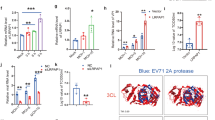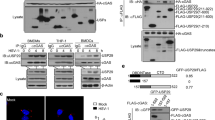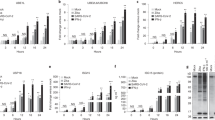Abstract
Innate immune responses provide the host with an early protection barrier against infectious agents, including viruses, and help shape the nature and quality of the subsequent adaptive immune responses of the host1. Expression of ISG15 (UCRP), a ubiquitin-like protein, and protein ISGylation are highly increased upon viral infection2,3,4. We have identified UBP43 (USP18) as an ISG15 deconjugating protease5. Protein ISGylation is enhanced in cells deficient in UBP43 (ref. 6). Here we have examined the role of UBP43, encoded by the gene Usp18, in innate immunity to virus infection. Usp18−/− mice were resistant to the fatal lymphocytic choriomeningitis and myeloencephalitis that developed in wild-type mice after intracerebral inoculation with lymphocytic choriomeningitis virus (LCMV) or vesicular stomatitis virus (VSV), respectively. Survival of Usp18−/− mice after intracerebral LCMV infection correlated with a severe inhibition of LCMV RNA replication and antigen expression in the brain and increased levels of protein ISGylation. Consistent with these findings, mouse embryonic fibroblasts (MEF) and bone marrow–derived macrophages from Usp18−/− mice showed restricted LCMV replication. Moreover, MEF from Usp18−/− mice showed enhanced interferon-mediated resistance to the cytopathic effect caused by VSV and Sindbis virus (SNV). This report provides the first direct evidence that the ISG15 protease UBP43 and possibly protein ISGylation have a role in innate immunity against viral infection.
This is a preview of subscription content, access via your institution
Access options
Subscribe to this journal
Receive 12 print issues and online access
$209.00 per year
only $17.42 per issue
Buy this article
- Purchase on Springer Link
- Instant access to full article PDF
Prices may be subject to local taxes which are calculated during checkout




Similar content being viewed by others
References
Biron, C.A. Initial and innate responses to viral infections-pattern setting in immunity or disease. Curr. Opin. Microbiol. 2, 374–381 (1999).
Farrell, P.J., Broeze, R.J. & Lengyel, P. Accumulation of an mRNA and protein in interferon-treated Ehrlich ascites tumour cells. Nature 279, 523–525 (1979).
Haas, A.L., Ahrens, P., Bright, P.M. & Ankel, H. Interferon induces a 15-kilodalton protein exhibiting marked homology to ubiquitin. J. Biol. Chem. 262, 11315–11323 (1987).
Kim, K.I. & Zhang, D.E. ISG15, not just another ubiquitin-like protein. Biochem. Biophys. Res. Commun. 307, 431–434 (2003).
Malakhov, M.P., Malakhova, O.A., Kim, K.I., Ritchie, K.J. & Zhang, D.E. UBP43 (USP18) specifically removes ISG15 from conjugated proteins. J. Biol. Chem. 277, 9976–9981 (2002).
Ritchie, K.J. et al. Dysregulation of protein modification by ISG15 results in brain cell injury. Genes Dev. 16, 2207–2212 (2002).
Merigan, T.C., Oldstone, M.B. & Welsh, R.M. Interferon production during lymphocytic choriomeningitis virus infection of nude and normal mice. Nature 268, 67–68 (1977).
Leist, T.P. et al. Lack of correlation between serum titres of interferon alpha, beta, natural killer cell activity and clinical susceptibility in mice infected with two isolates of lymphocytic choriomeningitis virus. J. Gen. Virol. 68, 2213–2218 (1987).
Loeb, K.R. & Haas, A.L. The interferon-inducible 15-kDa ubiquitin homolog conjugates to intracellular proteins. J. Biol. Chem. 267, 7806–7813 (1992).
Ritchie, K.J. & Zhang, D.E. ISG15: the immunological kin of ubiquitin. Semin. Cell Dev. Biol. 15, 237–246 (2004).
McGavern, D.B., Homann, D. & Oldstone, M.B. T cells in the central nervous system: the delicate balance between viral clearance and disease. J. Infect. Dis. 186 Suppl 2, S145–S151 (2002).
Buchmeier, M.J., Bowen, M.D. & Peters, C.J. in Fields Virology. (eds. Knipe, D. & Howley, P.) Ch. 50, 1635–1668 (Lippincott Williams & Wilkins, Philadelphia, 2000).
Doherty, P.C. Cell-mediated immunity in virus infections of the central nervous system. Ann. NY Acad. Sci. 540, 228–239 (1988).
Malakhov, M.P. et al. High-throughput immunoblotting. Ubiquitiin-like protein ISG15 modifies key regulators of signal transduction. J. Biol. Chem. 278, 16608–16613 (2003).
Gresser, I. & Enders, J.F. Alteration of cellular resistance to Sindbis virus in mixed cultures of human cells attributable to interferon. Virology 16, 428–435 (1962).
Ito, Y. & Montagnier, L. Heterogeneity of the sensitivity of vesicular stomatitis virus to interferons. Infect. Immun. 18, 23–27 (1977).
Pfau, C.J., Gresser, I. & Hunt, K.D. Lethal role of interferon in lymphocytic choriomeningitis virus-induced encephalitis. J. Gen. Virol. 64, 1827–1830 (1983).
Cousens, L.P. et al. Two roads diverged: interferon alpha/beta- and interleukin 12-mediated pathways in promoting T cell interferon gamma responses during viral infection. J. Exp. Med. 189, 1315–1328 (1999).
Ou, R., Zhou, S., Huang, L. & Moskophidis, D. Critical role for alpha/beta and gamma interferons in persistence of lymphocytic choriomeningitis virus by clonal exhaustion of cytotoxic T cells. J. Virol. 75, 8407–8423 (2001).
Yuan, W. & Krug, R.M. Influenza B virus NS1 protein inhibits conjugation of the interferon (IFN)-induced ubiquitin-like ISG15 protein. EMBO J. 20, 362–371 (2001).
Malakhova, O.A. et al. Protein ISGylation modulates the JAK-STAT signaling pathway. Genes Dev. 17, 455–460 (2003).
Hamerman, J.A. et al. Serpin 2a is induced in activated macrophages and conjugates to a ubiquitin homolog. J. Immunol. 168, 2415–2423 (2002).
Darnell, J.E., Jr, Kerr, I.M. & Stark, G.R. Jak-STAT pathways and transcriptional activation in response to IFNs and other extracellular signaling proteins. Science 264, 1415–1421 (1994).
Muller, U. et al. Functional role of type I and type II interferons in antiviral defense. Science 264, 1918–1921 (1994).
Dutko, F.J. & Oldstone, M.B. Genomic and biological variation among commonly used lymphocytic choriomeningitis virus strains. J. Gen. Virol. 64, 1689–1698 (1983).
Holland, J.J. et al. Virus mutation frequencies can be greatly underestimated by monoclonal antibody neutralization of virions. J. Virol. 63, 5030–5036 (1989).
Hahn, Y.S., Guanzon, A., Rice, C.M. & Hahn, C.S. Class I MHC molecule-mediated inhibition of Sindbis virus replication. J. Immunol. 162, 69–77 (1999).
Pinschewer, D.D., Perez, M., Sanchez, A.B. & de la Torre, J.C. Recombinant lymphocytic choriomeningitis virus expressing vesicular stomatitis virus glycoprotein. Proc. Natl. Acad. Sci. USA 100, 7895–7900 (2003).
Lewicki, H. et al. CTL escape viral variants. I. Generation and molecular characterization. Virology 210, 29–40 (1995).
Homann, D. et al. Evidence for an underlying CD4 helper and CD8 T-cell defect in B-cell-deficient mice: failure to clear persistent virus infection after adoptive immunotherapy with virus-specific memory cells from muMT/muMT mice. J. Virol. 72, 9208–9216 (1998).
Acknowledgements
We thank members of the DEZ laboratory for valuable discussions, M. Shen and J. Kuan for animal husbandry and genotyping, K. Edelmann for assistance with the analysis of virus-specific T-cell responses. This work is supported by National Institutes of Health Grants CA079849 (DEZ), GM066955 (DEZ), and AI047140 (JCT). The Stein Endowment Fund has partially supported the Department of Molecular and Experimental Medicine departmental molecular biology service laboratory for DNA sequencing and oligonucleotide synthesis. This is manuscript 16008-MEM from The Scripps Research Institute.
Author information
Authors and Affiliations
Corresponding authors
Ethics declarations
Competing interests
The authors declare no competing financial interests.
Rights and permissions
About this article
Cite this article
Ritchie, K., Hahn, C., Kim, K. et al. Role of ISG15 protease UBP43 (USP18) in innate immunity to viral infection. Nat Med 10, 1374–1378 (2004). https://doi.org/10.1038/nm1133
Received:
Accepted:
Published:
Issue Date:
DOI: https://doi.org/10.1038/nm1133
This article is cited by
-
Myeloid cell interferon responses correlate with clearance of SARS-CoV-2
Nature Communications (2022)
-
Further host-genomic characterization of total antibody response to PRRSV vaccination and its relationship with reproductive performance in commercial sows: genome-wide haplotype and zygosity analyses
Genetics Selection Evolution (2021)
-
USP18 positively regulates innate antiviral immunity by promoting K63-linked polyubiquitination of MAVS
Nature Communications (2021)
-
The USP18 cysteine protease promotes HBV production independent of its protease activity
Virology Journal (2020)
-
Ubiquitin and the DNA double-strand break repair pathway
Genome Instability & Disease (2020)



